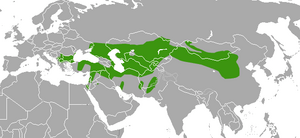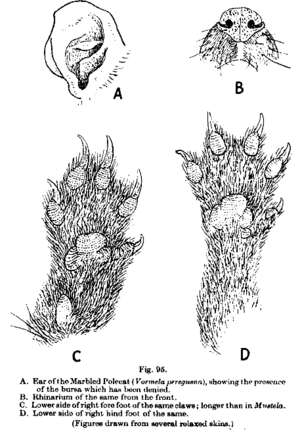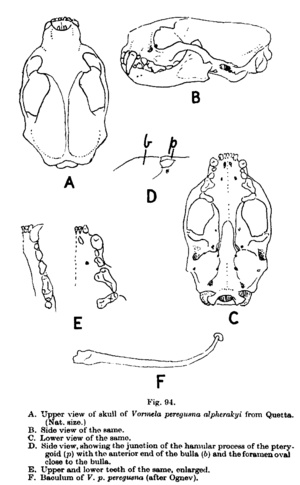Marbled polecat facts for kids
Quick facts for kids Marbled polecat |
|
|---|---|
 |
|
| Adult marbled polecat (Vormela peregusna) | |
| Conservation status | |
| Scientific classification | |
| Kingdom: | |
| Class: | |
| Order: | |
| Family: | |
| Subfamily: | |
| Genus: |
Vormela
|
| Binomial name | |
| Vormela peregusna |
|
 |
|
| Marbled polecat range | |
The marbled polecat (Vormela peregusna) is a small mammal. It belongs to the Mustelinae subfamily, which includes animals like weasels and ferrets.
Marbled polecats live in grasslands. You can find them from southeast Europe all the way to Asia. Their home countries include Russia, China, Turkey, Iran, Afghanistan, parts of Pakistan, northern India, Mongolia, and Kazakhstan. Like other animals in its family, the marbled polecat can release a very strong, bad-smelling liquid from special glands under its tail if it feels scared or threatened.
Contents
What Does a Marbled Polecat Look Like?
Marbled polecats are usually about 29 to 35 centimeters (about 11 to 14 inches) long, not counting their tail. They have a short nose and very large, easy-to-spot ears. Their legs are short, but their claws are long and strong.
Their tail is long and covered with long hair. The rest of their fur is short. Their face has black and white markings, including a black stripe across their eyes and white fur around their mouth. The fur on their back is yellow with many reddish or brown spots. Their tail is dark brown with a yellowish band in the middle. Their belly and legs are dark brown. Female polecats weigh between 295 and 600 grams (about 0.6 to 1.3 pounds). Males are a bit heavier, weighing from 320 to 715 grams (about 0.7 to 1.6 pounds).
Where Do Marbled Polecats Live?
Marbled polecats are found across a wide area. This stretches from southeast Europe into Russia and China. Their range includes countries like Bulgaria, Georgia, Turkey, Romania, Lebanon, Syria, Jordan, Israel, Palestine, Armenia, Azerbaijan, Iran, Afghanistan, and north-western Pakistan. They also live in Mongolia, China, Kazakhstan, and up to the Altai Steppes in Siberia. In 1998, one was even seen in the Sinai Peninsula in Egypt.
How Do Marbled Polecats Behave?
Marbled polecats are most active in the morning and evening. They don't see very well, so they use their excellent sense of smell to find their way around. They don't make many sounds. When they do, it's usually shrill alarm cries, grunts, or a long shriek if they are giving up.
These animals prefer to be alone. They move a lot within their home area, which is about 0.5 to 0.6 square kilometers (about 0.2 square miles). They usually only stay in one shelter for a short time. When two marbled polecats meet, they often act aggressively towards each other.
If a marbled polecat feels scared, it will stand up on its legs. It will arch its back and curl its tail over its back, making the long tail hair stand up. It might also lift its head, show its teeth, and make short, shrill hisses. If it feels very threatened, it can spray a foul-smelling liquid from glands under its tail.
When digging a den, the marbled polecat uses its front legs to scoop out earth. It holds itself steady with its chin and back legs. It can even use its teeth to pull out things like roots that are in the way.
Reproduction and Life Cycle
Marbled polecats mate from March to early June. Their mating calls often sound like low, rumbling noises in a slow rhythm. The time a mother carries her babies (gestation) can be quite long, from 243 to 327 days.
A mother polecat usually has four to eight cubs in a litter. Only the female takes care of the young. The cubs open their eyes when they are about 38 to 40 days old. They stop drinking their mother's milk (wean) at 50 to 54 days old. They leave their mother and go off on their own when they are about 61 to 68 days old.
Ecology
Where Marbled Polecats Live
Marbled polecats live in open deserts, semi-deserts, and dry, rocky areas. They can be found in upland valleys and low hills, steppe country, and dry subtropical scrub forests. They tend to stay away from mountains. Sometimes, marbled polecats are even seen in farm areas, like melon patches or vegetable fields.
They often use burrows dug by large ground squirrels or similar rodents, like the great gerbil. These burrows are used for resting and raising their young. They can also dig their own dens or live in underground irrigation tunnels. In winter, marbled polecats will line their dens with grass to make them warmer.
What Marbled Polecats Eat
Marbled polecats eat a variety of foods. Their diet includes ground squirrels, Libyan jirds, Armenian hamsters, voles, mole rats, house mice, and other small rodents. They also eat small hares, birds, lizards, fish, frogs, snails, and insects like beetles and crickets. They have also been known to eat fruit and grass. Sometimes, they might even take small farm animals like chickens and pigeons, or even steal smoked meat and cheese!
Marbled Polecats and Humans
In the past, people hunted marbled polecats for their fur. This fur was known as "fitch" or "perwitsky" in the fur trade.
In 1945, shopkeepers in Kabul were said to have kept marbled polecats. They used them to get rid of rodents like mice and rats. However, some people who kept them reported feeling unwell because of the strong smell the polecats release when they are scared. This could cause symptoms like a fever or an upset stomach.
Images for kids
See also
 In Spanish: Turón jaspeado para niños
In Spanish: Turón jaspeado para niños






